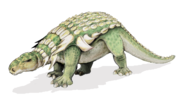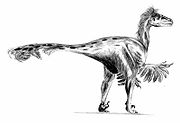
Ferris Formation
Encyclopedia
The Ferris Formation is a Late Cretaceous
(~66-65 Ma) to Paleocene
(65-63 Ma), fluvial-deltaic geological formation in southern Wyoming. It contains a variety of trace and body fossils, preserved in sandy fluvial channel deposits and overbank units. Dinosaur remains are fragmentary, but include Triceratops
, Tyrannosaurus
, dromaeosaurids, Paronychodon
, Ricardoestesia
, Edmontosaurus
, Edmontonia
, Ankylosaurus
, and Pachycephalosaurus
.
Some of the fluvial channels contain evidence of tidal influence and brackish water, in the form of tidal facies, shark teeth, and shrimp burrows. This demonstrates that the western shoreline of the Western Interior Sea was still within a few hundred kilometers even during the latest Cretaceous. The local K-T boundary is contained within a sandy channel deposit made up of stacked bars. Reworked Cretaceous fossils are preserved at the base of the channel complex, associated with mud rip-up clasts, and Paleocene mammal fossils are preserved in the upper portion of the bar.
The Ferris Formation is up to 2,000 m thick in the Hanna Basin and represents rapid accumulation of predominantly fine-grained sediment on a broad delta. The delta previously fed the deepwater Lewis Shale and shallow marine Fox Hills Formation. The Ferris followed behind as a system of lagoons, bays, and delta plain environments.
Myledaphus,
Lissodus
,
Cretorectolobus,
Phylodus,
Amia
,
Lepisosteus
,
Basilemys,
Adocus,
Trionychidae
,
Leptochamops,
Brachychampsa
,
Leidyosuchus
,
and a variety of Cretaceous and Paleocene multituberculates, marsupial
, and placentals.
Late Cretaceous
The Late Cretaceous is the younger of two epochs into which the Cretaceous period is divided in the geologic timescale. Rock strata from this epoch form the Upper Cretaceous series...
(~66-65 Ma) to Paleocene
Paleocene
The Paleocene or Palaeocene, the "early recent", is a geologic epoch that lasted from about . It is the first epoch of the Palaeogene Period in the modern Cenozoic Era...
(65-63 Ma), fluvial-deltaic geological formation in southern Wyoming. It contains a variety of trace and body fossils, preserved in sandy fluvial channel deposits and overbank units. Dinosaur remains are fragmentary, but include Triceratops
Triceratops
Triceratops is a genus of herbivorous ceratopsid dinosaur which lived during the late Maastrichtian stage of the Late Cretaceous Period, around 68 to 65 million years ago in what is now North America. It was one of the last dinosaur genera to appear before the great Cretaceous–Paleogene...
, Tyrannosaurus
Tyrannosaurus
Tyrannosaurus meaning "tyrant," and sauros meaning "lizard") is a genus of coelurosaurian theropod dinosaur. The species Tyrannosaurus rex , commonly abbreviated to T. rex, is a fixture in popular culture. It lived throughout what is now western North America, with a much wider range than other...
, dromaeosaurids, Paronychodon
Paronychodon
Paronychodon was a theropod dinosaur genus. It is a tooth taxon, considered dubious because of the fragmentary nature of the fossils, which include "buckets" of teeth but no other remains...
, Ricardoestesia
Ricardoestesia
Richardoestesia is a medium-sized genus of theropod dinosaur from the late Cretaceous Period of what is now North America. It is known from a single pair of lower jaw bones and a large number of isolated teeth....
, Edmontosaurus
Edmontosaurus
Edmontosaurus is a genus of crestless hadrosaurid dinosaur. It contains two species: Edmontosaurus regalis and Edmontosaurus annectens. Fossils of E. regalis have been found in rocks of western North America that date from the late Campanian stage of the Cretaceous Period 73 million years ago,...
, Edmontonia
Edmontonia
Edmontonia was an armoured dinosaur, a part of the nodosaur family from the Late Cretaceous Period. It is named after the Edmonton Formation , the unit of rock it was found in.-Description:...
, Ankylosaurus
Ankylosaurus
Ankylosaurus is a genus of ankylosaurid dinosaur, containing one species, A. magniventris...
, and Pachycephalosaurus
Pachycephalosaurus
Pachycephalosaurus is a genus of pachycephalosaurid dinosaur. It lived during the Late Cretaceous Period of what is now North America. Remains have been excavated in Montana, South Dakota, and Wyoming. It was an herbivorous or omnivorous creature which is only known from a single skull and a few...
.
Some of the fluvial channels contain evidence of tidal influence and brackish water, in the form of tidal facies, shark teeth, and shrimp burrows. This demonstrates that the western shoreline of the Western Interior Sea was still within a few hundred kilometers even during the latest Cretaceous. The local K-T boundary is contained within a sandy channel deposit made up of stacked bars. Reworked Cretaceous fossils are preserved at the base of the channel complex, associated with mud rip-up clasts, and Paleocene mammal fossils are preserved in the upper portion of the bar.
The Ferris Formation is up to 2,000 m thick in the Hanna Basin and represents rapid accumulation of predominantly fine-grained sediment on a broad delta. The delta previously fed the deepwater Lewis Shale and shallow marine Fox Hills Formation. The Ferris followed behind as a system of lagoons, bays, and delta plain environments.
Vertebrate paleofauna
In addition to a variety of dinosaurs, the following taxa are known from the Ferris Formation:Myledaphus,
Lissodus
Lissodus
Lissodus is an extinct genus of freshwater shark. It lived from the Early Triassic to the Albian period of the Cretaceous. It was about long and had flat teeth that it used for eating clams....
,
Cretorectolobus,
Phylodus,
Amia
Amia
Amia, AMIA, or AMiA can refer to:*American Medical Informatics Association*Bowfin, a fish genus*Anglican Mission in the Americas*Asociación Mutual Israelita Argentina, a Jewish community center located in Buenos Aires, Argentina...
,
Lepisosteus
Lepisosteus
Lepisosteus is a genus of gars in the family Lepisosteidae.There are four species:* Lepisosteus oculatus Winchell, 1864 * Lepisosteus osseus...
,
Basilemys,
Adocus,
Trionychidae
Trionychidae
Trionychidae is a taxonomic family which comprises a number of turtle genera commonly known as softshells. They are also sometimes called pancake turtles. Softshells consist of some of the world's largest fresh water turtles, though many can adapt to living in highly brackish areas. Members of this...
,
Leptochamops,
Brachychampsa
Brachychampsa
Brachychampsa is an extinct genus of alligatoroid. Specimens have been found from New Mexico, Colorado, Wyoming, Montana, North and South Dakota, New Jersey, and Saskatchewan. One specimen has been found from the Darbasa Formation of Kazakhstan, although the species status is indeterminant for the...
,
Leidyosuchus
Leidyosuchus
Leidyosuchus is an extinct genus of alligatoroid from the Late Cretaceous of Alberta. It was named in 1907 by Lawrence Lambe, and the type species is L. canadensis. It is known from a number of specimens from the middle Campanian age Dinosaur Park Formation...
,
and a variety of Cretaceous and Paleocene multituberculates, marsupial
Marsupial
Marsupials are an infraclass of mammals, characterized by giving birth to relatively undeveloped young. Close to 70% of the 334 extant species occur in Australia, New Guinea, and nearby islands, with the remaining 100 found in the Americas, primarily in South America, but with thirteen in Central...
, and placentals.
Ornithischians
| Ornithischians of the Ferris Formation | ||||||
|---|---|---|---|---|---|---|
| Genus | Species | Location | Stratigraphic position | Abundance | Notes | Images |
Ankylosaurus Ankylosaurus Ankylosaurus is a genus of ankylosaurid dinosaur, containing one species, A. magniventris... |
Indeterminate |
  |
||||
Edmontonia Edmontonia Edmontonia was an armoured dinosaur, a part of the nodosaur family from the Late Cretaceous Period. It is named after the Edmonton Formation , the unit of rock it was found in.-Description:... |
E. rugosidens |
|||||
Stygimoloch Stygimoloch Stygimoloch is a putative genus of pachycephalosaurid dinosaur from the end of the Cretaceous period, roughly 65 million years ago... |
S. spinifer |
|||||
Thescelosaurus Thescelosaurus Thescelosaurus was a genus of small ornithopod dinosaur that appeared at the very end of the Late Cretaceous period in North America. It was a member of the last dinosaurian fauna before the Cretaceous-Tertiary extinction event around 65.5 million years ago... |
Indeterminate |
|||||
Triceratops Triceratops Triceratops is a genus of herbivorous ceratopsid dinosaur which lived during the late Maastrichtian stage of the Late Cretaceous Period, around 68 to 65 million years ago in what is now North America. It was one of the last dinosaur genera to appear before the great Cretaceous–Paleogene... |
Indeterminate |
Ferris remains previously attributed to Triceratops have been subsequently identified as indeterminate chasmosaurine fossils. |
||||
Saurischians
| Saurischians of the Ferris Formation | ||||||
|---|---|---|---|---|---|---|
| Genus | Species | Location | Stratigraphic position | Abundance | Notes | Images |
Aublysodon Aublysodon Aublysodon is a name given to a large number of carnivorous dinosaur teeth of a certain form found in numerous late Cretaceous period geological formations... |
A. mirandus |
  |
||||
Dromaeosaurus Dromaeosaurus Dromaeosaurus was a genus of theropod dinosaur which lived during the Late Cretaceous period , sometime between 76.5 and 74.8 million years ago, in the western United States and Alberta, Canada. The name means 'running lizard'.... |
Indeterminate |
|||||
Ornithomimus Ornithomimus Ornithomimus is a genus of ornithomimid dinosaur from the Late Cretaceous Period of what is now North America.In 1890 Ornithomimus velox was named by Othniel Charles Marsh on the basis of a foot and partial hand from the Maastrichtian Denver Formation. Another seventeen species have been named since... |
O. velox |
|||||
Paronychodon Paronychodon Paronychodon was a theropod dinosaur genus. It is a tooth taxon, considered dubious because of the fragmentary nature of the fossils, which include "buckets" of teeth but no other remains... |
P. lacustris |
|||||
Ricardoestesia Ricardoestesia Richardoestesia is a medium-sized genus of theropod dinosaur from the late Cretaceous Period of what is now North America. It is known from a single pair of lower jaw bones and a large number of isolated teeth.... |
Indeterminate |
|||||
Saurornitholestes Saurornitholestes Saurornitholestes is a genus of carnivorous dromaeosaurid theropod dinosaur from the late Cretaceous of Alberta, Montana and New Mexico.... |
Indeterminate |
|||||
Struthiomimus Struthiomimus Struthiomimus is a genus of ornithomimid dinosaur from the late Cretaceous of Alberta, Canada. It was a long-legged, ostrich-like dinosaur.The bipedal Struthiomimus stood about long and tall at the hips and weighed around... |
Indeterminate |
|||||
Troodon Troodon Troodon is a genus of relatively small, bird-like dinosaur from the Late Cretaceous period . Discovered in 1855, it was among the first dinosaurs found in North America... |
T. formosus |
|||||
Tyrannosaurus Tyrannosaurus Tyrannosaurus meaning "tyrant," and sauros meaning "lizard") is a genus of coelurosaurian theropod dinosaur. The species Tyrannosaurus rex , commonly abbreviated to T. rex, is a fixture in popular culture. It lived throughout what is now western North America, with a much wider range than other... |
T. rex |
|||||

